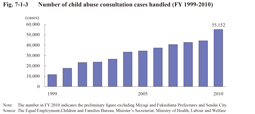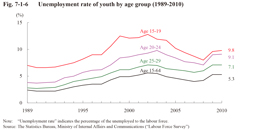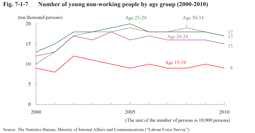Chapter 1 Current Situation surrounding Japanese Youth
Fig. 7-1-1 shows the population of criminally responsible juveniles (population of juveniles aged 14 or older who have thus reached the minimum age of criminal responsibility) and that of young and elderly people since 1989. The aging population and the declining birth rate resulted in a decrease to approximately 60% of the population of criminally responsible juveniles and approximately 84% of the population of young people over the period between 1989 and 2010. Trends with juvenile delinquents and young offenders therefore need to be evaluated with adequate consideration to the decreasing trend of the population of both criminally responsible juveniles and young people.
Fig. 7-1-1 Population of criminally responsible juveniles (aged 14-19) and young people, etc. by age group (1989-2010)
Next, the actual situation with the environment of families is outlined. Fig. 7-1-2 shows the divorce rate and number of single parent households (households consisting of either a single father or mother and unmarried children) since 1989. The divorce rate rose from 1989, reached a peak in 2002, and then generally remained stable from 2005. The number of single parent households was, however, gradually increasing every year. These trends can also be observed in the family environments of juvenile delinquents (See Fig. 3-1-5-4 and Fig. 7-2-3-9).
Fig. 7-1-2 Divorce rate and number of single parent households (1989-2010)
Fig. 7-1-3 shows the number of child abuse consultation cases handled at child guidance centers nationwide since FY 1999. Abuse experience as a child is an important issue in considering the treatment of juvenile delinquents, etc. The number of cases was increasing every year and reached a record high level in FY 2010 of approximately 4.7 times the number in FY 1999 when the Child Abuse Prevention Act had yet to be enforced, thus indicating that the problem of child abuse was growing ever more serious. In addition, the number of cleared cases/persons involving child abuse was also increasing (See Table 5-1-6-2).
Fig. 7-1-3 Number of child abuse consultation cases handled (FY 1999-2010)
The employment status of juveniles is observed next. Fig. 7-1-4 shows the employment rate of new senior/junior high school graduates since 1989. While the employment rate of new high school graduates generally remained at a high level, that of new junior high school graduates greatly depended on the economic situation and associated trends in labour markets with their situation particularly worsening in recent years.
Fig. 7-1-4 Employment rate by educational level (1989-2010)
Fig. 7-1-5 shows the turnover rate within one year after employment of new graduates by their educational level. The percentage of senior/junior high school graduates who left their jobs within one year after being employed was high, with that of junior high school graduates being remarkably high at consistently over 40%, thus indicating the instability of their employment status.
Fig. 7-1-5 Turnover rate within one year after employment by educational level (1989-2010)
Fig. 7-1-6 shows the unemployment rate of youth by age group since 1989. The unemployment rate was generally on a rising trend when compared to 1989, but that of youth in the age group younger than 25 was particularly high, thus indicating the difficulty in their getting and keeping employed.
Fig. 7-1-6 Unemployment rate of youth by age group (1989-2010)
Fig. 7-1-7 shows the number of young non-working people (those aged 15-34 but not in the labour force (excluding “those employed” and “those unemployed”) that are not engaged in housework nor attending school) by age group since 2000. The number of non-working people aged 20 or older was larger when compared to juveniles. In addition, the number of non-working people was large across all age groups and remained at basically the same level in recent years.
Fig. 7-1-7 Number of young non-working people by age group (2000-2010)






